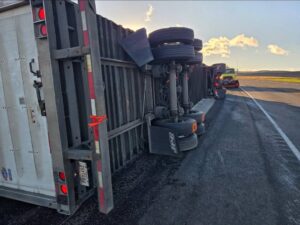RUCKERSVILLE, Va. — Crashes are up by as much as 6 percent in Colorado, Nevada, Oregon and Washington, compared with neighboring states that haven’t legalized marijuana for recreational use, new research from the Insurance Institute for Highway Safety (IIHS) and Highway Loss Data Institute (HLDI) shows. The findings come as campaigns to decriminalize marijuana gain traction with voters and legislators in the U.S., and Canada begins allowing recreational use of marijuana this month.
The two new studies will be presented today at the Combating Alcohol- and Drug-Impaired Driving summit, hosted by IIHS and HLDI at the Vehicle Research Center. The summit brings together highway safety and law enforcement experts to discuss the prevalence and associated risk of alcohol- and drug-impaired driving, as well as strategies to combat impaired driving.
Colorado and Washington were the first states to legalize recreational marijuana for adults 21 and older with voter approval in November 2012. Retail sales began in January 2014 in Colorado and in July 2014 in Washington. Oregon voters approved legalized recreational marijuana in November 2014, and sales started in October 2015. Nevada voters approved recreational marijuana in November 2016, and retail sales began in July 2017.
HLDI analysts estimate that the frequency of collision claims per insured vehicle year rose a combined 6 percent following the start of retail sales of recreational marijuana in Colorado, Nevada, Oregon and Washington, compared with the control states of Idaho, Montana, Utah and Wyoming. The combined-state analysis is based on collision loss data from January 2012 through October 2017.
Analysts controlled for differences in the rated driver population, insured vehicle fleet, the mix of urban versus rural exposure, unemployment, weather and seasonality.
Collision claims are the most frequent kind of claims insurers receive. Collision coverage insures against physical damage to a driver’s vehicle in a crash with an object or other vehicle, generally when the driver is at fault. Claim frequencies are expressed as the number of claims per 100 insured vehicle years. An insured vehicle year is one vehicle insured for one year or two vehicles insured for six months each.
A separate IIHS study examined 2012–16 police-reported crashes before and after retail sales began in Colorado, Oregon and Washington. IIHS estimates that the three states combined saw a 5.2 percent increase in the rate of crashes per million vehicle registrations, compared with neighboring states that didn’t legalize marijuana sales.
IIHS researchers compared the change in crash rate in Colorado, Oregon and Washington with the change in crash rates in the neighboring states that didn’t enact recreational marijuana laws. Researchers compared Colorado with Nebraska, Wyoming and Utah, and they compared Oregon and Washington with Idaho and Montana. The study controlled for differences in demographics, unemployment and weather in each state.
The size of the effect varied by state. Although the study controlled for several differences among the states, the models can’t capture every single difference. For example, marijuana laws in Colorado, Oregon and Washington differ in terms of daily purchase limits, sales taxes and available options for home growers. These differences can influence how often consumers buy marijuana, where they buy it and where they consume it.
The 5.2 percent increase in police-reported crash rates following legalization of recreational marijuana use is consistent with the 6 percent increase in insurance claim rates estimated by HLDI.
“The new IIHS-HLDI research on marijuana and crashes indicates that legalizing marijuana for all uses is having a negative impact on the safety of our roads,” says IIHS-HLDI President David Harkey. “States exploring legalizing marijuana should consider this effect on highway safety.”
Marijuana is still an illegal controlled substance under federal law.
In addition to the study states, Alaska, California, Maine, Massachusetts, Vermont and the District of Columbia also allow recreational use of marijuana for adults 21 and older and medical use of marijuana. Another 22 states allow medical marijuana, while 15 more states permit the use of specific cannabis products for designated medical conditions.
Legalization of recreational use is pending in New Hampshire, New Jersey, New York and Pennsylvania. In November, Michigan and North Dakota will hold referendums on marijuana, and Missouri and Utah voters will decide whether to expand medical marijuana laws in their states.
Driving under the influence of marijuana is illegal in all 50 states and D.C., but determining impairment is challenging. Unlike alcohol, the amount of marijuana present in a person’s body doesn’t consistently relate to impairment. THC, or Tetrahydrocannabinol, is the primary psychoactive component of cannabis. A positive test for THC and its active metabolite doesn’t mean the driver was impaired at the time of the crash. Habitual users of marijuana may have positive blood tests for THC days or weeks after using the drug.
Marijuana’s role in crashes isn’t as clear as the link between alcohol and crashes. Many states don’t include consistent information on driver drug use in crash reports, and policies and procedures for drug testing are inconsistent. More drivers in crashes are tested for alcohol than for drugs. When drivers are tested, other drugs are often found in combination with alcohol, which makes it difficult to isolate their separate effects.
“Despite the difficulty of isolating the specific effects of marijuana impairment on crash risk, the evidence is growing that legalizing its use increases crashes,” Harkey says.
The Trucker News Staff produces engaging content for not only TheTrucker.com, but also The Trucker Newspaper, which has been serving the trucking industry for more than 30 years. With a focus on drivers, the Trucker News Staff aims to provide relevant, objective content pertaining to the trucking segment of the transportation industry. The Trucker News Staff is based in Little Rock, Arkansas.














